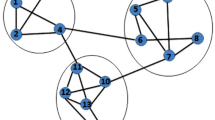Abstract
Social networks often demonstrate a hierarchical organization, with communities embedded within other communities; moreover, nodes can be shared between different communities, i.e. communities in social networks may be overlapping. In this paper, we define a hierarchical overlapping community structure to present overlapping communities of a social network at different levels of granularity. Discovering the hierarchical overlapping community structure of a social network can provide us a deeper understanding of the complex nature of social networks. We propose an algorithm, called D-HOCS, to derive the hierarchical overlapping community structure of social networks. Firstly, D-HOCS generates a probability transition matrix by applying random walk to a social network, and then trains a Gaussian Mixture Model using the matrix. Further D-HOCS derives overlapping communities by analyzing mean vectors of the Gaussian mixture model. Varying the number of components, D-HOCS repeatedly trains the Gaussian mixture model, detecting the overlapping communities at different levels of granularity. Organizing the overlapping communities into a hierarchy, D-HOCS can finally obtain the hierarchical overlapping community structure of the social network. The experiments conducted on synthetic and real dataset demonstrate the feasibility and applicability of the proposed algorithm. We further employ D-HOCS to explore Enron e-mail corpus, and obtain several interesting insights. For example, we find out a coordinator who coordinated many sections of the Enron Corporation to complete an important task during first half of 2001. We also identify a community that corresponds to a real organization in Enron Corporation.








Similar content being viewed by others
References
Ahn, Y.-Y., Bagrow, J.P., Lehmann, S. (2010). Link communities reveal multiscale complexity in networks. Nature, 466(5), 761–764.
Chapanond, A., Krishnamoorthy, M.S., Yener, B. (2005). Graph theoretic and spectral analysis of Enron e-mail data. Computational & Mathematical Organization Theory, 11, 261–281.
Chekuri, C., Goldberg, A., Karger, D., Levin, M., Stein, C. (1997). Experimentao study of minimum cut algorithms. In Proc. 8th ACM-SAIM symposium on discreet algorithm (pp. 324–333).
Clauset, A., Moore, C., Newman, M.E.J. (2008). Hierarchical structure and the prediction of missing links in networks. Nature, 453, 98–101.
Craswell, N., & Szummer, M. (2007). Random walks on the click graph. In Proceedings of the 30th annual international ACM SIGIR conference (pp. 239–246).
Diesner, J., Frantz, T.L., Carley, K.M. (2005). Communication network from the enrom e-mail corpus “It’s always about the people. Enron is no different”. Computational & Mathematical Organization Theory, 11, 201–228.
Ding, C., He, X., Zha, H., Gu, M., Simon, H. (2001). A min-max cut algorithm for graph partitioning and data clustering. In Proc. of ICDM 2001 (pp. 107–114).
Friggeri, A., Chelius, G., Fleury, E. (2011). Triangles to capture social cohesion. In 2011 IEEE international conference on privacy, security, risk, and trust, and IEEE international conference on social computing (pp. 258–265).
Gong, M., Chen, X., Ma, L., Zhang, Q., Jiao, L. (2013). Identification of multi-resolution network structures with multi-objective immune algorithm. Applied Soft Computing, 13, 1705–1717.
Gregory, S. (2009). Finding overlapping communities using disjoint community detection algorithms. In Complex Networks, Studies in Computational Intelligence (vol. 207, pp. 47–61). Springer, Heidelberg.
Gregory, S. (2011). Fuzzy overlapping communities in networks. Journal of Statistical Mechanics Theory and Experiment, 2011(2), P02017.
Huang, J., Sun, H., Han, J., Deng, H., Sun, Y., Liu, Y. (2010). SHRINK: a structural clustering algorithm for detecting hierarchical communities in networks. In Proceedings of CIKM’10 (pp. 219–228).
Lancichinetti, A., Fortunato, S., Kertész, J. (2009). Detecting the overlapping and hierarchical community structure in complex networks. New Journal of Physics, 11(3), 033015.
Lee, C., Reid, F., McDaid, A., Hurley, N. (2010). Detecting highly overlapping community structure by greedy clique expansion. In 4th SNA-KDD Workshop ’10 (SNA-KDD’10) (pp. 112–119).
Leicht, E.A., Clarkson, G., Shedden, K., Newman, M.E.J. (2007). Large-scale structure of time evolving citation networks. The European Physical Journal B; Condensed Matter and Complex Systems, 59(1), 75–83.
McCallum, A., & Wang, X. (2007). Topic and role discovery in social networks with experiments on Enron and academic e-mail. Journal of Artificial Intelligence Research, 30, 249–272.
Newman, M.E.J. (2004). Fast algorithm for detecting community structure in networks. Physical Review, E69, 066133.
Newman, M.E.J. (2010). Networks: An introduction. Oxford, UK: Oxford University Press.
Newman, M.E.J., & Girvan, M. (2004). Finding and evaluating community structure in networks. Physical Review, E69(026113), 1–15.
Palla, G., Derényi, I., Farkas, I., Vicsek, T. (2005). Uncovering the overlapping community structure of complex networks in nature and society. Nature, 435, 814–818.
Shen, H., Cheng, X., Cai, K., Hu, M.-B. (2009). Detect overlapping and hierarchical community structure in networks. Physica A Statistical Mechanics and its Applications, 388(8), 1706–1712.
Shen, H.-W., Cheng, X.-Q., Guo, J.-F. (2009). Quantifying and identifying the overlapping community structure in networks. Journal of Statistical Mechanics: Theory and Experiment, 2009(7), P07042.
Shi, J., & Malik, J. (2000). Normalized cuts and image segmentation. IEEE Transactions on Pattern Analysis and Machine Intelligence, 22(8), 888–905.
Xu, X., Yuruk, N., Feng, Z., Schweiger, T.A.J. (2007). SCAN: a structural clustering algorithm for networks. In Proceeding of SIGKDD’07 (pp 824–833).
Yang, B., Jin, D., Liu, J., Liu, D. (2013). Hierarchical community detection with applications to real-world network analysis. Data & Knowledge Engineering, 83, 20–38.
Zachary, W.W. (1977). An information flow model for conflict and fission in small groups. Journal of Anthropological Research, 33, 452–473.
Acknowledgements
This work was supported by the Major Program of the National Natural Science Foundation of China (Grant Number: 91218301), as well as the Fundamental Research Funds for the Central University of China (JBK130923, JBK120515).
Author information
Authors and Affiliations
Corresponding author
Rights and permissions
About this article
Cite this article
Qiu, J., Lin, Z. D-HOCS: an algorithm for discovering the hierarchical overlapping community structure of a social network. J Intell Inf Syst 42, 353–370 (2014). https://doi.org/10.1007/s10844-013-0272-5
Received:
Revised:
Accepted:
Published:
Issue Date:
DOI: https://doi.org/10.1007/s10844-013-0272-5




